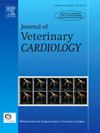Diagnosis of congestive heart failure by combining echocardiography and blood biomarkers in cats with cardiomyopathy
IF 1.3
2区 农林科学
Q2 VETERINARY SCIENCES
引用次数: 0
Abstract
Introduction/Objectives
In cats with cardiomyopathy, echocardiographic indices and blood biomarkers such as atrial natriuretic peptide (ANP), cardiac troponin I (cTnI), and N-terminal pro-B-type natriuretic peptide (NTproBNP) are useful in diagnosing congestive heart failure (CHF). However, the improvement in diagnostic accuracy by combining these indicators remains unclear.
Animals, materials and methods
Twenty-six cats diagnosed with cardiomyopathy using echocardiography were included in this study. They were classified into CHF and non-CHF groups according to the presence of pulmonary oedema or pleural effusion and response to heart failure treatment. The discriminative ability of each index for the presence of CHF was evaluated using a receiver operating characteristic curve.
Results
The left atrial-to-aortic root ratio (LA/Ao) had the highest area under the curve of 0.952 (95% confidence interval [CI]: 0.878–1.0), followed by ANP 0.915 (95% CI 0: 0.808–1.0), cTnI 0.861 (95% CI: 0.722–0.999), and NTproBNP 0.830 (95% CI: 0.672–0.988). Adding NTproBNP and ANP to the LA/Ao did not improve the discriminative ability. Limited by the combination of blood biomarkers, ANP and cTnI showed the highest discriminative ability.
Study Limitations
Following were the limitations to this study: lack of standardised medication, inability to calculate true correlation for NTproBNP values >1500 pmol/L, marked difference in disease severity between groups, inclusion of various cardiomyopathy types, reliance solely on LA/Ao for left atrial size assessment, and small sample size.
Conclusions
This study indicates that if LA/Ao can be measured accurately, the significance of measuring cardiac biomarkers for diagnosing CHF in cats with cardiomyopathy is low.
结合超声心动图和血液生物标志物对心肌病猫充血性心力衰竭的诊断
在患有心肌病的猫中,超声心动图指标和血液生物标志物如心房利钠肽(ANP)、心肌肌钙蛋白I (cTnI)和n端前b型利钠肽(NTproBNP)对诊断充血性心力衰竭(CHF)很有帮助。然而,通过结合这些指标来提高诊断准确性仍不清楚。动物、材料和方法采用超声心动图诊断为心肌病的猫26只。根据是否存在肺水肿或胸腔积液以及对心力衰竭治疗的反应将患者分为CHF组和非CHF组。采用受试者工作特征曲线评价各指标对CHF存在的判别能力。结果左房主动脉根比(LA/Ao)曲线下面积最大,为0.952(95%可信区间[CI]: 0.878 ~ 1.0),其次为ANP 0.915 (95% CI 0: 0.808 ~ 1.0)、cTnI 0.861 (95% CI: 0.722 ~ 0.999)、NTproBNP 0.830 (95% CI: 0.672 ~ 0.988)。在LA/Ao中加入NTproBNP和ANP并没有提高LA/Ao的识别能力。受血液生物标志物组合的限制,ANP和cTnI表现出最高的区分能力。以下是本研究的局限性:缺乏标准化的药物治疗,无法计算NTproBNP值>;1500 pmol/L的真实相关性,组间疾病严重程度的显着差异,包括各种心肌病类型,仅依赖LA/Ao评估左房大小,样本量小。结论本研究表明,如果能够准确测量LA/Ao,则测量心脏生物标志物对心肌病猫CHF诊断的意义较低。
本文章由计算机程序翻译,如有差异,请以英文原文为准。
求助全文
约1分钟内获得全文
求助全文
来源期刊

Journal of Veterinary Cardiology
VETERINARY SCIENCES-
CiteScore
2.50
自引率
25.00%
发文量
66
审稿时长
154 days
期刊介绍:
The mission of the Journal of Veterinary Cardiology is to publish peer-reviewed reports of the highest quality that promote greater understanding of cardiovascular disease, and enhance the health and well being of animals and humans. The Journal of Veterinary Cardiology publishes original contributions involving research and clinical practice that include prospective and retrospective studies, clinical trials, epidemiology, observational studies, and advances in applied and basic research.
The Journal invites submission of original manuscripts. Specific content areas of interest include heart failure, arrhythmias, congenital heart disease, cardiovascular medicine, surgery, hypertension, health outcomes research, diagnostic imaging, interventional techniques, genetics, molecular cardiology, and cardiovascular pathology, pharmacology, and toxicology.
 求助内容:
求助内容: 应助结果提醒方式:
应助结果提醒方式:


